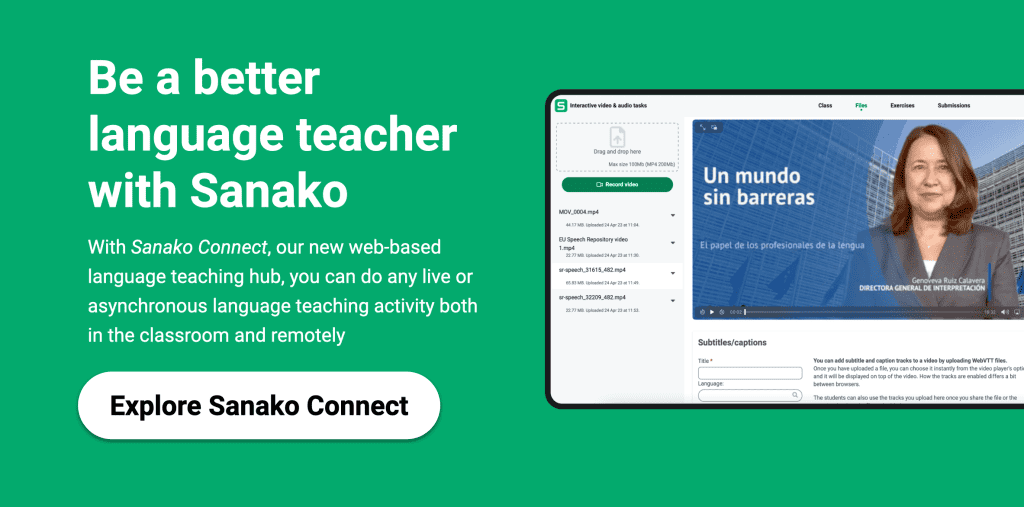One of the most significant trends to emerge in language learning over the last couple of years has been the unstoppable rise of blended or hybrid learning. Although not a new approach to teaching, blended learning was essential in helping institutions, students and teachers to cope with the impacts of the Covid-19 pandemic.
Certainly most language courses have always sought to combine a variety of delivery modes (e.g face-to-face, lectures, tutorials, workshops etc.). And “good teachers will always use more than one method or approach in their teaching, and good learners will always combine different strategies in their learning” (Marsh, 2012). But what does blended learning look like in 2023 and beyond, how does it work and is it effective for all stakeholders?
What is blended language learning / teaching?
As with most terms used in education, blended learning can be used to mean a variety of different things. One widely-used definition is that provided by the Online Learning Consortium, which defines blended learning as a course where:
“Online activity is mixed with classroom meetings, replacing a significant percentage, but not all required face-to-face instructional activities. When the technologies used for education and communication outside the classroom are used to supplant some, but not all face-to-face instruction, reducing the time actually spent in the classroom, the result is a blended classroom course.”
It’s worth noting, as Edwige Simon does here, that “the very use of the word blended indicates that the online portion of the course is essential rather than supplemental.” Simon and the OLC both also point out that blended learning is also sometimes referred to as hybrid learning.
Benefits of blended learning for teachers and students
A review of the literature in the space clearly identifies a number of benefits associated with blended learning for all stakeholders. The most notable are summarised below.
- The blended approach is deemed to be particularly appropriate for language learning. It enables learners to study with aural / visual texts rather than written material, but also gives them the opportunity to have both. As a CUP report on the topic suggests: “students can watch a video or listen to audio whilst at the same time reading a transcript.” Students are therefore able to work on their listening and reading skills simultaneously.
- Linked to the above, teachers can also tailor a blended learning course to the specific learning preferences of all students. Visual learners can, for example, engage with a tailored selection of source materials in the classroom or online whereas solitary or interpersonal learners can flourish through asynchronous self-study content, online and remote from the institution.
- For many students, the focus on using online resources is also a significant motivator. Not only are they able to learn where and when they want, the online / technological element of the blended model can help to keep some students engaged and motivated to learn. High-quality interactive multimedia content (either provided by the teacher or sourced by the student) also provides meaningful content relevant to learners’ needs and interests.
- Blended learning can also help to develop more confident language learners. Opportunities to practice real life conversations online with their peers or on their own can be hugely powerful in overcoming fears of speaking in class. As Marsh 2012 identifies, students can learn “at their own pace and in their own time and as a result come to class much better prepared for speaking activities.” Working on their own also gives students the chance to practice and review what they have learnt in the classroom.
- Importantly blended learning is also highly effective. The US Department of Education published a detailed analysis in 2010 of over 1,000 studies comparing blended, face-to-face and online-only courses. The study concluded that blended learning was the most effective of the three models.
As demonstrated during the recent Covid-pandemic, a blended learning approach also offers advantages to institutions as well. Not only can lessons be delivered more flexibly in terms of location and content, it also makes more efficient use of resources by reducing the need for fixed language resources. Furthermore, as teaching is not now limited to the physical space in a classroom, an infinite number of students could (in theory) be reached and taught as long as they have an internet connection.
How can institutions best adopt blended learning strategies?
The key to delivering a successful blended learning approach is to use and combine the strengths of each medium appropriately. Take the time to ensure that the mode of delivery always puts the student at the heart of the learning process. There must therefore be a clear connection between what students do at home and what they do in class. Otherwise students may be less motivated to complete the online assignments (they’re just optional) or even come to class (everything’s now online).
In an August 2016 paper on Blended Language Learning, Cambridge University Press made the following suggestion:
When the online environment within a blended approach is used appropriately, it empowers learners, provides them with rich interactive input, gives them just-in-time support, helps them become independent learners and encourages learner discovery.
And when the classroom environment within a blended approach is used appropriately, it is an effective way for teachers to fulfill their multidimensional role. It gives teachers the possibility of giving more individual attention to learners, it maximises social interaction in the classroom, and it facilitates teacher–learner communication outside the classroom.
Best practice suggests that presentational activities are, for example, well suited to online delivery. Rather than using the lesson time to go through 25 presentations, students can record them at home and can then discuss key themes and ask questions in groups when in class. This transforms a simple presentation task into an interactive, interpersonal one, all of which is conducted in the students’ target language. Similarly synchronous and asynchronous speaking practice with peers works well outside of class as do completing worksheets and gap-fill exercises.
One final tip for language educators considering switching to a blended approach is to ensure that your language learners have all the skills they need before changing over. Helping them to develop self-regulation and time management skills is essential, otherwise students simply drop off en route to dropping out. Incentives to reward students who come to class fully prepared and ready to go might also be something for educators to consider.
How do Sanako products help educators deliver blended language learning?
Sanako produces a range of language teaching tools that are tailored to helping educators to deploy a blended learning approach. For example our browser-based language teaching solution, Sanako Connect, enables educators to:
- Quickly set up their live or asynchronous classes in minutes. Educators are able to teach remotely, in the classroom or in a blended combination.
- Deliver classes synchronously – through real-time chat functionality or conversation – or asynchronously so that students can work at their own pace – all this in one platform.
- Divide students into pair or group discussions. Educators can also listen in and give detailed feedback live or in recording after the session has been completed.
- Create specific lesson activities by uploading a wide variety of stimulus materials including text files, PDFs, presentations and web pages or by building gap-fill and multiple-choice quizzes.
- Provide detailed text and audio feedback, helping students to understand what went well and where further work might be needed.
Sanako is the global-leader in teacher-led language instruction technology. Our software supports language teachers to deliver inspiring and effective lessons. If you’d like to find out more about how Sanako’s dedicated language teaching software could transform your approach to language teaching, click here or the banner below to learn more!
This blog post was last updated 23 August, 2023.

